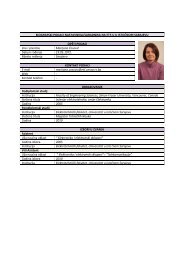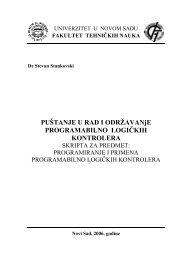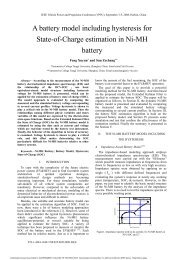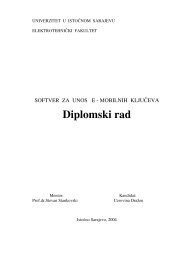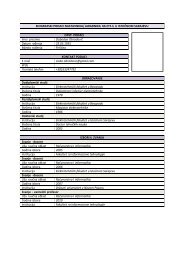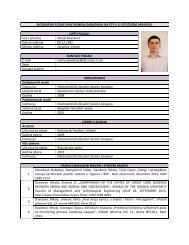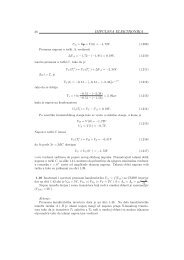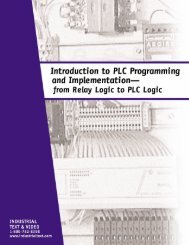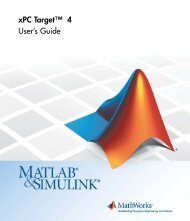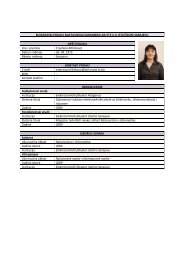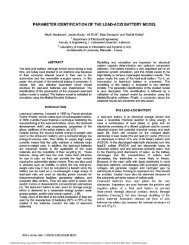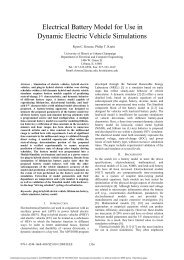Accurate Electrical Battery Model Capable of Predicting Runtime ...
Accurate Electrical Battery Model Capable of Predicting Runtime ...
Accurate Electrical Battery Model Capable of Predicting Runtime ...
You also want an ePaper? Increase the reach of your titles
YUMPU automatically turns print PDFs into web optimized ePapers that Google loves.
CHEN AND RINCÓN-MORA: BATTERY MODEL CAPABLE OF PREDICTING RUNTIME AND I–V PERFORMANCE 505<br />
TABLE I<br />
COMPARISON OF VARIOUS CIRCUIT MODELS<br />
Fig. 1. State <strong>of</strong> the art. (a) Thevenin-, (b) impedance-, and (c) runtime-based<br />
electrical battery models.<br />
most mathematical models only work for specific applications<br />
and provide inaccurate results in the order <strong>of</strong> 5%–20% error.<br />
For example, the maximum error <strong>of</strong> Peukert’s law predicting<br />
runtime can be more than 100% for time-variant loads [16].<br />
<strong>Electrical</strong> models [4], [19]–[30], accuracy <strong>of</strong> which lies between<br />
electrochemical and mathematical models (around 1%–<br />
5% error), are electrical equivalent models using a combination<br />
<strong>of</strong> voltage sources, resistors, and capacitors for co-design and<br />
cosimulation with other electrical circuits and systems. For electrical<br />
engineers, electrical models are more intuitive, useful, and<br />
easy to handle, especially when they can be used in circuit simulators<br />
and alongside application circuits. There have been many<br />
electrical models <strong>of</strong> batteries, from lead-acid to polymer Li-ion<br />
batteries. Most <strong>of</strong> these electrical models fall under three basic<br />
categories: Thevenin- [19]–[25], impedance- [26], [27], and<br />
runtime-based models [4], [28], [29], as shown in Fig. 1.<br />
A. Thevenin-Based <strong>Electrical</strong> <strong>Model</strong><br />
In its most basic form, a Thevenin-based model, shown in<br />
Fig. 1(a), uses a series resistor (R Series ) and an RC parallel<br />
network (R Transient and C Transient ) to predict battery response to<br />
transient load events at a particular state <strong>of</strong> charge (SOC), by<br />
assuming the open-circuit voltage [V OC (SOC)] is constant. Unfortunately,<br />
this assumption prevents it from capturing steadystate<br />
battery voltage variations (i.e., dc response) as well as<br />
runtime information.<br />
Its derivative models [19]–[25] gain improvements by adding<br />
additional components to predict runtime and dc response, but<br />
they still have several disadvantages. For example, [19] uses a<br />
variable capacitor instead <strong>of</strong> V OC (SOC) to represent nonlinear<br />
open-circuit voltage and SOC, which complicates the capacitor<br />
parameter, needs the integral over voltage to obtain SOC,<br />
and gives roughly 5% runtime error and 0.4-V error voltage for<br />
constant charge and discharge currents; [20] models the nonlinear<br />
relation between the open-circuit voltage and SOC, but<br />
ignores the transient behavior; [21], [22] and [24] need additional<br />
mathematical equations to obtain the SOC and estimate<br />
runtime, and they are not implemented in circuit simulators; [23]<br />
adopts two constant RC parallel networks, but only works at a<br />
particular SOC and temperature condition; [25] employs a complicated<br />
electrical network extracted from physical process to<br />
model open-circuit voltage (V OC ), which complicates the whole<br />
model. Thus, none <strong>of</strong> these Thevenin-based models can predict<br />
the battery runtime simply and accurately in circuit simulators.<br />
B. Impedance-Based <strong>Electrical</strong> <strong>Model</strong><br />
Impedance-based models, shown in Fig. 1(b), employ the<br />
method <strong>of</strong> electrochemical impedance spectroscopy to obtain<br />
an ac-equivalent impedance model in the frequency domain,<br />
and then use a complicated equivalent network (Z ac ) to fit the<br />
impedance spectra. The fitting process is difficult, complex, and<br />
nonintuitive. In addition, impedance-based models only work<br />
for a fixed SOC and temperature setting [26], and therefore they<br />
cannot predict dc response or battery runtime.<br />
C. <strong>Runtime</strong>-Based <strong>Electrical</strong> <strong>Model</strong><br />
<strong>Runtime</strong>-based models, shown in Fig. 1(c), use a complex<br />
circuit network to simulate battery runtime and dc voltage response<br />
for a constant discharge current in SPICE-compatible<br />
simulators. [28] and [29] are continuous-time implementations<br />
in SPICE simulators and [4] is a discrete-time implementation<br />
using Very high speed integrated circuit Hardware Description<br />
Language (VHDL) code. They can predict neither runtime nor<br />
voltage response for varying load currents accurately.<br />
A brief comparison illustrated in Table I indicates that none<br />
<strong>of</strong> these models can be implemented in circuit simulators to<br />
predict both the battery runtime and I–V performance accurately.<br />
Therefore, a comprehensive battery model combining the<br />
transient capabilities <strong>of</strong> Thevenin-based models, ac features <strong>of</strong><br />
impedance-based models, and runtime information <strong>of</strong> runtimebased<br />
models is highly desired for system design, integration,<br />
and optimization.<br />
III. PROPOSED MODEL<br />
An accurate, intuitive, and comprehensive electrical battery<br />
model is proposed in Fig. 2. On the left, a capacitor (C Capacity )<br />
and a current-controlled current source, inherited from runtimebased<br />
models, model the capacity, SOC, and runtime <strong>of</strong> the battery.<br />
The RC network, similar to that in Thevenin-based models,<br />
simulates the transient response. To bridge SOC to open-circuit<br />
voltage, a voltage-controlled voltage source is used. The proposed<br />
model is a blend <strong>of</strong> previous models whose unique combination<br />
<strong>of</strong> components and dependencies eases the extraction<br />
Authorized licensed use limited to: GOVERNMENT COLLEGE OF TECHNOLOGY. Downloaded on December 31, 2009 at 04:50 from IEEE Xplore. Restrictions apply.



